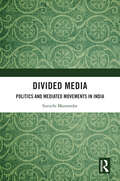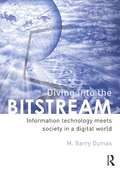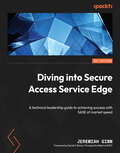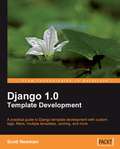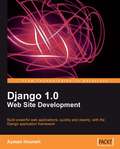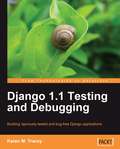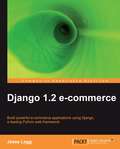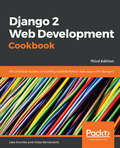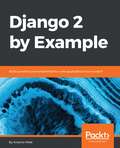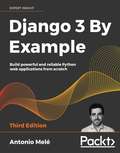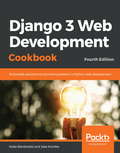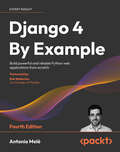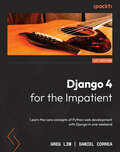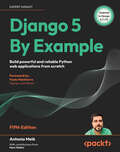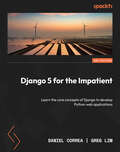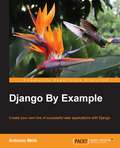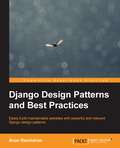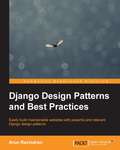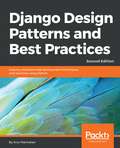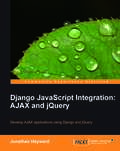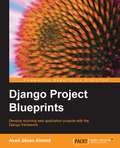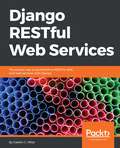- Table View
- List View
Divided Media: Politics and Mediated Movements in India
by Suruchi MazumdarThis book addresses the complex relationship between India’s evolving, emerging media landscape, the political and economic interests of diverse media actors, and movements opposing contentious issues such as market-based economic reforms and religious nationalism.Through the complexities of mainstream news media and emerging digital culture in the eastern city of Kolkata, this book foregrounds regional and linguistic variations in the studies of media, movements, and politics in India. By focusing on popular movements against agricultural land acquisition in the state of West Bengal, in 2006 and 2007, and contemporary citizen-led activisms, this book captures the tension between mainstream media’s political and commercial logic, movements and digital activisms questioning dominant development and religious nationalist agenda, and the possibilities of political diversity and democratic participation. Situating the study in a multi-hybrid digital space that intimately integrates the old and new media, this book draws on critical, thematic analysis of newspaper coverage, digital qualitative studies of techno-commercial features such as hashtags and viral videos, and extensive interviews. This book proposes the theoretical concept of a hybrid partisan system, and argues that heterogeneity –– the complex, dynamic interaction of commercially-run media’s political alliances, the commercial logic, and hybrid professional norms –– remains consequential for movement visibilities, but contributes to deep ambiguities and commonalities in core issues such as industrialization in a developing economy.This book would be relevant to scholars of journalism, political communication, media systems, and mediated activisms in communication studies, sociology, political science, and South Asian studies.
Diving Into the Bitstream: Information Technology Meets Society in a Digital World
by Barry M. DumasNationwide, and indeed worldwide, there has been a growing awareness of the importance of access to information. Accordingly, information technology (IT), broadly defined and its role beyond the internal workings of businesses has leapt into the social consciousness. Diving into the Bitstream distinguishes itself by weaving together the concepts and conditions of IT. What distinguishes these trends is their focus on the impacts of IT on societies, and the responsibilities of IT's creators and users. The author pulls together important, often complex issues in the relationships among information, information technologies, and societal constructs. The text explores a synopsis of these issues that are foundations for further consideration.
Diving into Secure Access Service Edge: A technical leadership guide to achieving success with SASE at market speed
by David H. Brown Jeremiah GinnImplement Secure Access Service Edge (SASE) for secure network and application communications, exploring SASE services including SD-WAN, ZTF, and more with expert Jeremiah Ginn who helps CxO leaders achieve SASE successKey FeaturesMerge networking and security services into a single architecture to simplify network infrastructureExplore how zero trust network access (ZTNA) restricts access to provide native application segmentationFocus on a native, multitenant cloud architecture that scales dynamically with demandBook DescriptionThe SASE concept was coined by Gartner after seeing a pattern emerge in cloud and SD-WAN projects where full security integration was needed. The market behavior lately has sparked something like a "space race" for all technology manufacturers and cloud service providers to offer a "SASE" solution. The current training available in the market is minimal and manufacturer-oriented, with new services being released every few weeks. Professional architects and engineers trying to implement SASE need to take a manufacturer-neutral approach.This guide provides a foundation for understanding SASE, but it also has a lasting impact because it not only addresses the problems that existed at the time of publication, but also provides a continual learning approach to successfully lead in a market that evolves every few weeks. Technology teams need a tool that provides a model to keep up with new information as it becomes available and stay ahead of market hype.With this book, you'll learn about crucial models for SASE success in designing, building, deploying, and supporting operations to ensure the most positive user experience (UX). In addition to SASE, you'll gain insight into SD-WAN design, DevOps, zero trust, and next-generation technical education methods.What you will learnDevelop a comprehensive understanding of SASE from a market and technical perspectiveUnderstand SASE services and components included in SASE solutionsMove logically from prescriptive design to policy-based design and orchestrationUnderstand standard SASE use cases and how to integrate future componentsConvert from a legacy network design model to a secure DevOps model for future projectsUse a functional design overlay to eliminate inter-service competition for the control plane of the SASE serviceWho this book is forThis book is for technology and security leaders and specifically for any CTO, CSO, CISO, or CIO looking for an executive approach to SASE for their organization. Anyone implementing SD-WAN, SASE, and SASE services for cloud, network, and security infrastructure will also find this book helpful.
Diy Wifi
by Katrina JungnickelWho makes WiFi? Why do different makers matter? What do barbeques and backyards have to do with the internet? This book explores how WiFi is made from the ground up, or in this case from the backyard out. Forged around barbeques, made of found, adapted and off-the-shelf materials and installed in ordinary domestic spaces, this book documents the collective work of individuals committed to making 'Ournet not the internet'. Drawing on rich ethnographic material, Jungnickel's research on community WiFi networking provides an overdue account of the innovative digital cultures and practices of ordinary people making extra-ordinary things. What make-do methods, mods and tales of resourceful ingenuity permit is another way of seeing how technologies come into being. It brings to life an Australian version of WiFi, enriching global studies of wireless technology by signalling the potential of comparative studies. Critically, the book presents the first sustained study of homebrew high-tech backyard technologists who imbue a DIY ethos but do not do it alone - they Do-It-Together (DIT). This timely critique of collective DIT innovation in an increasingly networked society will be of interest to scholars and practitioners of maker culture.
Django 1.0 Template Development
by Scott NewmanThis book is designed for readers who learn by doing and employs many examples and screenshots to let the reader dig in and start coding. This book isn't designed to be a reference; instead it has a practical, example-driven approach that teaches you by following along with the examples in the chapters. When you have completed this book, you will fully understand how the template system works, how to extend it when you have specialized needs, and how to optimize the performance and usability of your content. This book is for web developers and template authors who want to fully understand and utilize the Django template system. The reader should have completed the introductory tutorials on the Django project's website and some experience with the framework will be very helpful. Basic knowledge of Python and HTML is assumed.
Django 1.0 Website Development
by Ayman HouriehThe simple and clear approach is ideal for beginners to Django. Packed with examples and screenshots, this book will help you learn the features of Django 1.0 and help you build a dynamic website using those features.This book is for web developers who want to learn to build a complete site with Web 2.0 features, using the power of a proven and popular development system, Django, but do not necessarily want to learn how the complete framework functions in order to do this. Basic knowledge of Python development is required for this book, but no knowledge of Django is expected.
Django 1.1 Testing and Debugging
by Karen M. TraceyThis book teaches by example. It walks in detail through development of a sample application, illustrating each step via complete working code and either screenshots or console snippets. The cumbersome and time consuming task of debugging will be a cake walk with this book. If you are a Django application developer who wants to create robust applications quickly that work well and are easy to maintain in the long term, this book is for you. This book is the right pick if you want to be smartly tutored to make best use of Django's rich testing and debugging support and make testing an effortless task. Basic knowledge of Python, Django, and the overall structure of a database-driven web application is assumed. However, the code samples are fully explained so that even beginners who are new to the area can learn a great deal from this book.
Django 1.2 e-commerce
by Jesse LeggPacked with code examples and configuration hints for related web technologies, the book helps you add a new feature to your store in each chapter. It also provides additional documentation and comments for popular web APIs. If you are a Django developer and wish to build an e-commerce application, then this book is for you. You need to be familiar with the basics of developing in Django.
Django 2 Web Development Cookbook: 100 practical recipes on building scalable Python web apps with Django 2, 3rd Edition
by Aidas Bendoraitis Jake KronikaCreate unbelievably fast, robust and secure web apps with Django Web Framework and Python 3.8Key FeaturesDiscover solutions to a variety of web application scenarios, leveraging the power of the Django frameworkUnderstand URL routing, models, forms, templates, and RESTful services with Django 2.14Test, deploy, and scale your web applications efficiently with Amazon Web ServicesBook DescriptionDjango is a framework designed to balance rapid web development with high performance. It handles high levels of user traffic and interaction, integrates with a variety of databases, and collects and processes data in real time. This book follows a task-based approach to guide you through developing with the Django 2.1 framework, starting with setting up and configuring Docker containers and a virtual environment for your project.You'll learn how to write reusable pieces of code for your models and manage database changes. You'll work with forms and views to enter and list data, applying practical examples using templates and JavaScript together for the optimum user experience. This cookbook helps you to adjust the built-in Django administration to fit your needs and sharpen security and performance to make your web applications as robust, scalable, and dependable as possible. You'll also explore integration with Django CMS, the popular content management suite.In the final chapters, you'll learn programming and debugging tricks and discover how collecting data from different sources and providing it to others in various formats can be a breeze. By the end of the book, you'll learn how to test and deploy projects to a remote dedicated server and scale your application to meet user demands.What you will learnGet started with the basic configuration necessary to start any Django projectBuild a database structure out of reusable model mixinsSecure web applications against malicious usage and address common performance bottlenecksIntegrate with, and extend, the Django CMSConstruct and manage complex and deep hierarchiesImport data from local sources and external web services and export it to third partiesWho this book is forThis book is designed for Python developers working on fast and secure web apps that can scale over time. You’ll also find this book useful if you want to upgrade to latest Django framework. A background in Python 3 along with basic knowledge of the Django framework will be useful.
Django 2 by Example: Build powerful and reliable Python web applications from scratch
by Antonio MeleLearn Django 2.0 with four end-to-end projectsKey FeaturesLearn Django by building real-world web applications from scratchDevelop powerful web applications quickly using the best coding practicesIntegrate other technologies into your application with clear, step-by-step explanations and comprehensive example codeBook DescriptionIf you want to learn about the entire process of developing professional web applications with Django, then this book is for you. This book will walk you through the creation of four professional Django projects, teaching you how to solve common problems and implement best practices.You will learn how to build a blog application, a social image-bookmarking website, an online shop, and an e-learning platform. The book will teach you how to enhance your applications with AJAX, create RESTful APIs, and set up a production environment for your Django projects. The book walks you through the creation of real-world applications, while solving common problems and implementing best practices. By the end of this book, you will have a deep understanding of Django and how to build advanced web applicationsWhat you will learnBuild practical, real-world web applications with DjangoUse Django with other technologies, such as Redis and CeleryDevelop pluggable Django applicationsCreate advanced features, optimize your code, and use the cache frameworkAdd internationalization to your Django projectsEnhance your user experience using JavaScript and AJAXAdd social features to your projectsBuild RESTful APIs for your applicationsWho this book is forIf you are a web developer who wants to see how to build professional sites with Django, this book is for you. You will need a basic knowledge of Python, HTML, and JavaScript, but you don't need to have worked with Django before.
Django 3 By Example: Build powerful and reliable Python web applications from scratch, 3rd Edition
by Antonio MeleLearn Django 3 with four end-to-end web projects Key Features Learn Django 3 by building real-world web applications from scratch in Python, using coding best practices Integrate other technologies into your application with clear, step-by-step explanations and comprehensive example code Implement advanced functionalities like a full-text search engine, a user activity stream, or a recommendation engine Add real-time features with Django Channels and WebSockets Book Description If you want to learn the entire process of developing professional web applications with Python and Django, then this book is for you. In the process of building four professional Django projects, you will learn about Django 3 features, how to solve common web development problems, how to implement best practices, and how to successfully deploy your applications. In this book, you will build a blog application, a social image bookmarking website, an online shop, and an e-learning platform. Step-by-step guidance will teach you how to integrate popular technologies, enhance your applications with AJAX, create RESTful APIs, and set up a production environment for your Django projects. By the end of this book, you will have mastered Django 3 by building advanced web applications. What you will learn Build real-world web applications Learn Django essentials, including models, views, ORM, templates, URLs, forms, and authentication Implement advanced features such as custom model fields, custom template tags, cache, middleware, localization, and more Create complex functionalities, such as AJAX interactions, social authentication, a full-text search engine, a payment system, a CMS, a RESTful API, and more Integrate other technologies, including Redis, Celery, RabbitMQ, PostgreSQL, and Channels, into your projects Deploy Django projects in production using NGINX, uWSGI, and Daphne Who this book is for This book is intended for developers with Python knowledge who wish to learn Django in a pragmatic way. Perhaps you are completely new to Django, or you already know a little but you want to get the most out of it. This book will help you to master the most relevant areas of the framework by building practical projects from scratch. You need to have familiarity with programming concepts in order to read this book. Some previous knowledge of HTML and JavaScript is assumed.
Django 3 Web Development Cookbook: Actionable solutions to common problems in Python web development, 4th Edition
by Aidas Bendoraitis Jake KronikaPractical recipes for building fast, robust, and secure web apps using Django 3 and Python Key Features Explore the latest version of Django, and learn effectively with the help of practical examples Follow a task-based approach to develop professional web apps using Django and Python Learn to deploy, scale, and secure apps using Docker and Amazon Web Services(AWS) Book Description Django is a web framework for perfectionists with deadlines, designed to help you build manageable medium and large web projects in a short time span. This fourth edition of Django Web Development Cookbook is updated with Django 3's latest features to guide you effectively through the development process. This Django book starts by helping you create a virtual environment and project structure for building Python web apps. You'll learn how to build models, views, forms, and templates for your web apps and then integrate JavaScript in your Django apps to add more features. As you advance, you'll create responsive multilingual websites, ready to be shared on social networks. The book will take you through uploading and processing images, rendering data in HTML5, PDF, and Excel, using and creating APIs, and navigating different data types in Django. You'll become well-versed in security best practices and caching techniques to enhance your website's security and speed. This edition not only helps you work with the PostgreSQL database but also the MySQL database. You'll also discover advanced recipes for using Django with Docker and Ansible in development, staging, and production environments. By the end of this book, you will have become proficient in using Django's powerful features and will be equipped to create robust websites. What you will learn Discover how to set the basic configurations to start any Django project Understand full-stack web application development using Django Build a database structure using reusable model mixins Implement security, performance, and deployment features in your web apps Import data from local sources and external web services and export it to your app Secure web applications against malicious usage and find and fix common performance bottlenecks Who this book is for This Django book is for Python web developers who want to build fast and secure web apps that can scale over time. You'll also find this book useful if you want to upgrade to the latest Django framework. Knowledge of Python 3, along with a basic understanding of the Django framework will help you make the most of this book.
Django 4 By Example: Build powerful and reliable Python web applications from scratch
by Antonio MeléPUBLISHER'S NOTE: A new edition of this book, updated for Django 5, is now available.Key FeaturesImplement advanced functionalities, such as full-text search engines, user activity streams, payment gateways, and recommendation enginesIntegrate JavaScript, PostgreSQL, Redis, Celery, and Memcached into your applicationsAdd real-time features with Django Channels and WebSocketsBook DescriptionDjango 4 By Example is the 4th edition of the best-selling franchise that helps you build web apps. This book will walk you through the creation of real-world applications, solving common problems, and implementing best practices using a step-by-step approach. You'll cover a wide range of web app development topics as you build four different apps: A blog application: Create data models, views, and URLs and implement an admin site for your blog. Create sitemaps and RSS feeds and implement a full-text search engine with PostgreSQL. A social website: Implement authentication with Facebook, Twitter, and Google. Create user profiles, image thumbnails, a bookmarklet, and an activity stream. Implement a user follower system and add infinite scroll pagination to your website. An e-commerce application: Build a product catalog, a shopping cart, and asynchronous tasks with Celery and RabbitMQ. Process payments with Stripe and manage payment notifications via webhooks. Build a product recommendation engine with Redis. Create PDF invoices and export orders to CSV. An e-learning platform: Create a content management system to manage polymorphic content. Cache content with Memcached and Redis. Build and consume a RESTful API. Implement a real-time chat using WebSockets with ASGI. Create a production environment using NGINX, uWSGI and Daphne with Docker Compose. This is a practical book that will have you creating web apps quickly.What you will learnLearn Django essentials, including models, ORM, views, templates, URLs, forms, authentication, signals and middlewareImplement different modules of the Django framework to solve specific problemsIntegrate third-party Django applications into your projectBuild asynchronous (ASGI) applications with DjangoSet up a production environment for your projectsEasily create complex web applications to solve real use casesWho this book is forThis book is for readers with basic Python knowledge and programmers transitioning from other web frameworks who wish to learn Django by doing. If you already use Django or have in the past, and want to learn best practices and integrate other technologies to scale your applications, then this book is for you too. This book will help you master the most relevant areas of the framework by building practical projects from scratch. Some previous knowledge of HTML and JavaScript is assumed.
Django 4 By Example: Build powerful and reliable Python web applications from scratch, 4th Edition
by Antonio Mele Bob BelderbosLearn to create fully functional web applications with authentication, content management systems, payment processing, RESTful APIs, and morePurchase of the print or Kindle book includes a free eBook in PDF format.Key FeaturesImplement advanced functionalities, such as full-text search engines, user activity streams, payment gateways, and recommendation enginesIntegrate JavaScript, PostgreSQL, Redis, Celery, and Memcached into your applicationsAdd real-time features with Django Channels and WebSocketsBook DescriptionDjango 4 By Example is the 4th edition of the best-selling franchise that helps you build web apps. This book will walk you through the creation of real-world applications, solving common problems, and implementing best practices using a step-by-step approach.You'll cover a wide range of web app development topics as you build four different apps:A blog application: Create data models, views, and URLs and implement an admin site for your blog. Create sitemaps and RSS feeds and implement a full-text search engine with PostgreSQL. A social website: Implement authentication with Facebook, Twitter, and Google. Create user profiles, image thumbnails, a bookmarklet, and an activity stream. Implement a user follower system and add infinite scroll pagination to your website.An e-commerce application: Build a product catalog, a shopping cart, and asynchronous tasks with Celery and RabbitMQ. Process payments with Stripe and manage payment notifications via webhooks. Build a product recommendation engine with Redis. Create PDF invoices and export orders to CSV.An e-learning platform: Create a content management system to manage polymorphic content. Cache content with Memcached and Redis. Build and consume a RESTful API. Implement a real-time chat using WebSockets with ASGI. Create a production environment using NGINX, uWSGI and Daphne with Docker Compose. This is a practical book that will have you creating web apps quickly.What you will learnLearn Django essentials, including models, ORM, views, templates, URLs, forms, authentication, signals and middlewareImplement different modules of the Django framework to solve specific problemsIntegrate third-party Django applications into your projectBuild asynchronous (ASGI) applications with DjangoSet up a production environment for your projectsEasily create complex web applications to solve real use casesWho this book is forThis book is for readers with basic Python knowledge and programmers transitioning from other web frameworks who wish to learn Django by doing. If you already use Django or have in the past, and want to learn best practices and integrate other technologies to scale your applications, then this book is for you too. This book will help you master the most relevant areas of the framework by building practical projects from scratch. Some previous knowledge of HTML and JavaScript is assumed.
Django 4 for the Impatient: Learn the core concepts of Python web development with Django in one weekend
by Greg Lim Daniel CorreaA quick-start guide to exploring and using Python and Django to develop web applications in minutesKey FeaturesDevelop web applications with Python and Django quicklyUnderstand Django features with short explanations and learn how to use them right awayCreate a movie reviews app with a responsive user interface and deploy it to the cloudBook DescriptionLearning Django can be a tricky and time-consuming activity. There are hundreds of tutorials, loads of documentation, and many explanations that are hard to digest. However, this book enables you to use and learn Django in just a couple of days. In this book, you'll go on a fun, hands-on, and pragmatic journey to learn Django full stack development. You'll start building your first Django app within minutes. You'll be provided with short explanations and a practical approach that cover some of the most important Django features, such as Django Apps' structure, URLs, views, templates, models, CSS inclusion, image storage, authentication and authorization, Django admin panel, and many more. You'll also use Django to develop a movies review app and deploy it to the internet. By the end of this book, you'll be able to build and deploy your own Django web applications.What you will learnUnderstand and implement Django Apps' basic structure, including URLs, views, templates, and modelsAdd bootstrap to improve the aesthetics of the siteCreate your own custom pages and have different URLs to route to themNavigate between pages by adding a header bar to all pagesWork with databases and modelsExplore the powerful built-in admin interface with DjangoUse Django's powerful, built-in authentication systemDeploy your Django project on the internet for the world to useWho this book is forThis book is for Python developers at any level of experience with Python programming who want to build full-stack Python web applications using Django. The book is for absolute Django beginners.
Django 4 for the Impatient: Learn the core concepts of Python web development with Django in one weekend
by Greg Lim Daniel CorreaA quick-start guide to exploring and using Python and Django to develop web applications in minutesKey FeaturesDevelop web applications with Python and Django quicklyUnderstand Django features with short explanations and learn how to use them right awayCreate a movie reviews app with a responsive user interface and deploy it to the cloudBook DescriptionLearning Django can be a tricky and time-consuming activity. There are hundreds of tutorials, loads of documentation, and many explanations that are hard to digest. However, this book enables you to use and learn Django in just a couple of days. In this book, you’ll go on a fun, hands-on, and pragmatic journey to learn Django full stack development. You'll start building your first Django app within minutes. You'll be provided with short explanations and a practical approach that cover some of the most important Django features, such as Django Apps’ structure, URLs, views, templates, models, CSS inclusion, image storage, authentication and authorization, Django admin panel, and many more. You'll also use Django to develop a movies review app and deploy it to the internet. By the end of this book, you'll be able to build and deploy your own Django web applications.What you will learnUnderstand and implement Django Apps' basic structure, including URLs, views, templates, and modelsAdd bootstrap to improve the aesthetics of the siteCreate your own custom pages and have different URLs to route to themNavigate between pages by adding a header bar to all pagesWork with databases and modelsExplore the powerful built-in admin interface with DjangoUse Django's powerful, built-in authentication systemDeploy your Django project on the internet for the world to useWho this book is forThis book is for Python developers at any level of experience with Python programming who want to build full-stack Python web applications using Django. The book is for absolute Django beginners.
Django 5 By Example: Build powerful and reliable Python web applications from scratch
by Antonio Melé2025 EDITION: Build four fully functional real-world Django applications with authentication, content management systems, payment processing, REST APIs, and more! Purchase of the print or Kindle book includes a free eBook in PDF format.Key FeaturesUpdated with the latest Django 5.2 features, detailed app planning, improved tooling, and GPT prompts for extending projectsLearn Django essentials, including models, ORM, views, templates, URLs, forms, authentication, signals, and middleware Integrate JavaScript, PostgreSQL, Redis, Celery, Docker, and Memcached into your applicationsBook DescriptionIf you want to learn Django by doing, this book is for you. This 2025 EDITION, fully updated to Django 5.2 LTS, is the fifth edition of the best-selling Django By Example franchise that helps you build real-world web apps. This book will walk you through planning and creation, solving common problems, and implementing best practices using a step-by-step approach. You’ll cover a wide range of web application development topics through four different projects: a blog application, a social website, an e-commerce application, and an e-learning platform. Pick up what’s new in Django 5 as you build end-to-end Python web apps, follow detailed project plans, and understand the hows and whys of Django. This is a practical and approachable book that will have you creating web apps quickly.What you will learnUse various Django modules to solve specific problems using the latest featuresIntegrate third-party Django applications into your projectBuild complex web applications using Redis, Postgres, Celery/RabbitMQ and MemcachedSet up a production environment for your project with Docker ComposeBuild a RESTful API with Django Rest Framework (DRF)Implement advanced functionalities, such as full-text search engines, user activity streams, payment gateways, and recommender enginesBuild real-time asynchronous (ASGI) apps with Django Channels and WebSocketsWho this book is forThis book is for readers with basic Python programming knowledge and programmers transitioning from other web frameworks who wish to learn Django by doing. If you already use Django, or have in the past, and want to learn best practices and integrate other technologies to scale your applications, then this book is for you too. This book will help you master the most relevant areas of the framework by building practical projects from scratch. Some previous knowledge of HTML and JavaScript is assumed.
Django 5 for the Impatient: Learn the core concepts of Django to develop Python web applications
by Daniel Correa Greg LimGet up and running with Django quickly by delving into practical code examples and build real-world Django applications Key FeaturesDevelop web applications with Python and Django quicklyUnderstand Django features with concise explanations and learn how to use them in a practical wayCreate a movie store app with a responsive user interface and deploy it to the cloudPurchase of the print or Kindle book includes a free PDF eBookBook DescriptionLearning Django can be a challenging and time-consuming activity without the right guidance. With hundreds of tutorials, loads of documentation, and unclear explanations out there, it’s easy to lose sight of what’s most important. This book stands out by teaching you how to use Django in just a few days with a focused approach. In this second edition, you’ll go on a fun, practical, and pragmatic journey to learning full-stack development with Django 5. You’ll start building your first Django app within minutes. As you progress, you’ll learn from concise explanations that will help you get to grips with some of the most important Django features, including URLs, views, templates, models, CSS inclusion, image storage, Django admin panel, and more. You’ll also understand how to design Django MVT (Model-View-Template) architectures and implement them. Additionally, you’ll use Django to develop a movie store application and deploy it to the internet. By the end of this book, you’ll be able to build and deploy your own Django web applications confidently.What you will learnUnderstand and use Django key features, including URLs, templates, models, and formsImplement responsive user interfaces using BootstrapManage data storage in databases effectivelyExplore the powerful built-in admin interface with DjangoHarness Django's powerful built-in authentication systemDeploy your Django project on the internet for usersWho this book is forThis book is for Python developers of any experience level who want to build full-stack web applications using Django. Anyone new to Django can get started with this book.
Django By Example
by Antonio MeleCreate your own line of successful web applications with Django About This Book * Learn Django by building four fully-functional, real-world web applications from scratch * Develop powerful web applications quickly using the best coding practices * Integrate other technologies into your application with clear, step-by-step explanations and comprehensive example code Who This Book Is For If you are a web developer who is completely new or familiar with Django and want to make the most out of it, this book is for you. Some basic knowledge of Python, HTML, and JavaScript is beneficial, but is not required. What You Will Learn * Build a search engine with Django and Solr * Add asynchronous tasks to applications with Celery * Create pluggable Django applications by building an activity stream system * Enhance the user experience using AJAX views * Extend the Django Admin site with custom actions * Use third-party Django applications to add social authentication to projects * Manage payments and orders by integrating a third-party payment gateway * Engage users by building a gamification system In Detail Django is a powerful Python web framework designed to solve all types of web development problems and questions, providing Python developers with an easy solution to web application development. With a wealth of third-party modules available, you'll be able to create a highly customizable web application with this powerful framework. This book will walk you through the creation of four professional Django projects and show you how to solve common problems and implement best practices. The book begins by first showing you how to create a simple blog and integrate it with third-party applications, before gradually moving on to extending this blog by adding features such as custom template tags and filters. You will build a complete social website, share its contents, track user actions in a timeline, and use Redis with Django to store item views. You will also build an online shop, manage its payments and orders, and add internationalization and localization to the project. Before you are introduced to content creation and building an evaluation system, you will build an e-learning application. Finally, you will build a gamification system where you will learn to build a badges application and get familiar with Django management commands. After reading this book, you will have a good understanding of how Django works and how to integrate it with other technologies. You will be able to build advanced Django applications for production use. Style and approach This is an easy-to-follow guide to building four different production-ready Django projects. Each project focuses on a particular area of the framework and each topic within the projects is explained with practical examples and includes best practice recommendations.
Django Design Patterns and Best Practices
by Arun RavindranIf you want to learn how best to utilize commonly found patterns and learn best practices in developing applications with Django, this is the book for you. This book, like Django itself, is accessible to amateur and professional developers alike and assumes little in the way of prior experience. Although written for Python 3, the majority of the code in this book works in Python 2 or can be easily translated.
Django Design Patterns and Best Practices
by Arun Ravindran<P><P>Easily build maintainable websites with powerful and relevant Django design patterns <P><P>About This Book <P><P>Unravel the common problems of web development in Django <P><P>Learn the current best practices while working in Django 1.7 and Python 3.4 <P><P>Experience the challenges of working on an end-to-end social network project <P><P>Who This Book Is For <P><P>If you want to learn how best to utilize commonly found patterns and learn best practices in developing applications with Django, this is the book for you. This book, like Django itself, is accessible to amateur and professional developers alike and assumes little in the way of prior experience. <P><P>Although written for Python 3, the majority of the code in this book works in Python 2 or can be easily translated. <P><P>What You Will Learn <P><P>Understand common design patterns that can help you write better Django code <P><P>Discover the latest best practices and idioms in this rapidly evolving framework <P><P>Deep dive into various aspects of Django from Models and Views to testing and deployment <P><P>Get to grips with difficult topics such as dealing with legacy code and debugging <P><P>Familiarize yourself with the various nuances of web development such as browser attacks and databases <P><P>Reduce the maintenance burden with well-tested, cleaner code <P><P>Show your work to the world by learning about hosting, deploying, and securing your Django projects <P><P>In Detail <P><P>Learning how to write better Django code to build more maintainable websites either takes a lot of experience or familiarity with various design patterns. Filled with several idiomatic Django patterns, Django Design Patterns and Best Practices accelerates your journey into the world of web development. <P><P>Discover a set of common design problems, each tackling aspects of Django including model design and Views, and learn several recommended solutions with useful code examples and illustrations. You'll also get to grips with the current best practices in the latest versions of Django and Python. Creating a successful web application involves much more than Django, so advanced topics including REST, testing, debugging, security, and deployment are also explored in detail.
Django Design Patterns and Best Practices: Industry-standard web development techniques and solutions using Python, 2nd Edition
by Arun RavindranBuild maintainable websites with elegant Django design patterns and modern best practicesKey FeaturesExplore aspects of Django from Models and Views to testing and deploymentUnderstand the nuances of web development such as browser attack and data designWalk through various asynchronous tools such as Celery and ChannelsBook DescriptionBuilding secure and maintainable web applications requires comprehensive knowledge. The second edition of this book not only sheds light on Django, but also encapsulates years of experience in the form of design patterns and best practices. Rather than sticking to GoF design patterns, the book looks at higher-level patterns. Using the latest version of Django and Python, you’ll learn about Channels and asyncio while building a solid conceptual background. The book compares design choices to help you make everyday decisions faster in a rapidly changing environment.You’ll first learn about various architectural patterns, many of which are used to build Django. You’ll start with building a fun superhero project by gathering the requirements, creating mockups, and setting up the project. Through project-guided examples, you’ll explore the Model, View, templates, workflows, and code reusability techniques. In addition to this, you’ll learn practical Python coding techniques in Django that’ll enable you to tackle problems related to complex topics such as legacy coding, data modeling, and code reusability.You’ll discover API design principles and best practices, and understand the need for asynchronous workflows. During this journey, you’ll study popular Python code testing techniques in Django, various web security threats and their countermeasures, and the monitoring and performance of your application.What you will learnMake use of common design patterns to help you write better codeImplement best practices and idioms in this rapidly evolving frameworkDeal with legacy code and debuggingUse asynchronous tools such as Celery, Channels, and asyncioUse patterns while designing API interfaces with the Django REST FrameworkReduce the maintenance burden with well-tested, cleaner codeHost, deploy, and secure your Django projectsWho this book is forThis book is for you whether you’re new to Django or just want to learn its best practices. You do not have to be an expert in Django or Python. No prior knowledge of patterns is expected for reading this book but it would be helpful.
Django JavaScript Integration: AJAX and jQuery
by Jonathan HaywardThis book will teach you how to enrich your AJAX applications with Django and jQuery in a practical manner with minimum fuss. It introduces AJAX basics, gets a little deeper, and then goes chapter-by-chapter through a carefully chosen case study. It demonstrates how different pieces of a Django AJAX application work in themselves and are put together and specifically leads you through building an intranet employee photo directory with social networking features. This book is for people looking to integrate AJAX / JavaScript functionality into their web applications. It is for Django users who are looking to easily integrate AJAX features into their applications. Conversely, it will also be a priceless companion for users familiar with Django and jQuery who are and looking to integrate them in their AJAX applications. A working knowledge of Django and basic familiarity with AJAX and jQuery are assumed.
Django Project Blueprints
by Asad Jibran AhmedDevelop stunning web application projects with the Django framework About This Book * Build six exciting projects and use them as a blueprint for your own work * Extend Django's built-in models and forms to add common functionalities into your project, without reinventing the wheel * Gain insights into the inner workings of Django to better leverage it Who This Book Is For If you are a Django web developer able to build basic web applications with the framework, then this book is for you. This book will help you gain a deeper understanding of the Django web framework by guiding you through the development of six amazing web applications. What You Will Learn * Share code between a client-facing application and Django's admin * Combine client and server-side code for enhanced functionality * Geo-enable your models to provide common functionality based on geography * Add a REST API to your models to allow other applications to interact with your code * Future-proof your code with unit and functional tests * Add e-commerce capabilities to your site, build a shopping cart, and issue refunds * Process information asynchronously using Web Sockets to provide a real-time user interface In Detail Django is a high-level web framework that eases the creation of complex, database-driven websites. It emphasizes on the reusability and pluggability of components, rapid development, and the principle of don't repeat yourself. It lets you build high-performing, elegant web applications quickly. There are several Django tutorials available online, which take as many shortcuts as possible, but leave you wondering how you can adapt them to your own needs. This guide takes the opposite approach by demonstrating how to work around common problems and client requests, without skipping the important details. If you have built a few Django projects and are on the lookout for a guide to get you past the basics and get you solving modern development tasks, this is your book. Six unique projects will take you through the development process from scratch, leaving no stone unturned. In the first two projects, you will learn everything from adding ranking and voting capabilities to your App to building geospatial queries and APIs. In the third project, we will build an e-commerce platform, complete with a payment processor, basic cart, checkout features, and more! Next, we will get into caching data asynchronously and create a real-time app capable of consuming live updates. When you're done, you'll have consistent patterns and techniques that you can build on for many projects to come. Style and approach This easy-to-follow guide is full of examples that will take you through building six very different web applications with Django. The code is broken down into manageable bites and then thoroughly explained.
Django RESTful Web Services: The easiest way to build Python RESTful APIs and web services with Django
by Gastón C. Hillar Norbert MátéDesign, build and test RESTful web services with the Django framework and Python Key Features Create efficient real-world RESTful web services with the latest Django framework Authenticate, secure, and integrate third-party packages efficiently in your Web Services Leverage the power of Python for faster Web Service development Book Description Django is a Python web framework that makes the web development process very easy. It reduces the amount of trivial code, which simplifies the creation of web applications and results in faster development. It is very powerful and a great choice for creating RESTful web services. If you are a Python developer and want to efficiently create RESTful web services with Django for your apps, then this is the right book for you. The book starts off by showing you how to install and configure the environment, required software, and tools to create RESTful web services with Django and the Django REST framework. We then move on to working with advanced serialization and migrations to interact with SQLite and non-SQL data sources. We will use the features included in the Django REST framework to improve our simple web service. Further, we will create API views to process diverse HTTP requests on objects, go through relationships and hyperlinked API management, and then discover the necessary steps to include security and permissions related to data models and APIs. We will also apply throttling rules and run tests to check that versioning works as expected. Next we will run automated tests to improve code coverage. By the end of the book, you will be able to build RESTful web services with Django. What you will learn The best way to build a RESTful Web Service or API with Django and the Django REST Framework Develop complex RESTful APIs from scratch with Django and the Django REST Framework Work with either SQL or NoSQL data sources Design RESTful Web Services based on application requirements Use third-party packages and extensions to perform common tasks Create automated tests for RESTful web services Debug, test, and profile RESTful web services with Django and the Django REST Framework Who this book is for This book is for Python developers who want to create RESTful web services with Django; you need to have a basic working knowledge of Django but no previous experience with RESTful web services is required.
